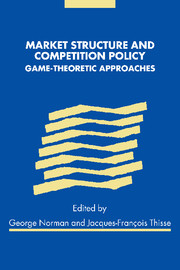Book contents
- Frontmatter
- Contents
- List of figures
- List of tables
- List of contributors
- Louis Phlips: a brief biography
- Introduction
- 1 Competition policy and game-theory: reflections based on the cement industry case
- 2 Legal standards and economic analysis of collusion in EC competition policy
- 3 A guided tour of the Folk Theorem
- 4 Predatory pricing and anti-dumping
- 5 Should pricing policies be regulated when firms may tacitly collude?
- 6 Tougher price competition or lower concentration: a trade-off for anti-trust authorities?
- 7 The strategic effects of supply guarantees: the raincheck game
- 8 Product market competition policy and technological performance
- 9 On some issues in the theory of competition in regulated markets
- 10 Modelling the entry and exit process in dynamic competition: an introduction to repeated-commitment models
- 11 Coordination failures in the Cournot approach to deregulated bank competition
- 12 How the adoption of a new technology is affected by the interaction between labour and product markets
- Index
4 - Predatory pricing and anti-dumping
Published online by Cambridge University Press: 22 September 2009
- Frontmatter
- Contents
- List of figures
- List of tables
- List of contributors
- Louis Phlips: a brief biography
- Introduction
- 1 Competition policy and game-theory: reflections based on the cement industry case
- 2 Legal standards and economic analysis of collusion in EC competition policy
- 3 A guided tour of the Folk Theorem
- 4 Predatory pricing and anti-dumping
- 5 Should pricing policies be regulated when firms may tacitly collude?
- 6 Tougher price competition or lower concentration: a trade-off for anti-trust authorities?
- 7 The strategic effects of supply guarantees: the raincheck game
- 8 Product market competition policy and technological performance
- 9 On some issues in the theory of competition in regulated markets
- 10 Modelling the entry and exit process in dynamic competition: an introduction to repeated-commitment models
- 11 Coordination failures in the Cournot approach to deregulated bank competition
- 12 How the adoption of a new technology is affected by the interaction between labour and product markets
- Index
Summary
The law and economics of predatory pricing is something of a swamp. Fortunately, it is not necessary to enter that swamp to discuss contemporary anti-dumping policy.
(Hindley, 1991, p. 29)Introduction
Recent years have seen the widespread use of anti-dumping (AD) measures by World Trade Organisation (WTO) members. But the most striking development in this field is the swift proliferation of the users of such measures. By the late 1990s, the exclusiveness of the club of traditional AD users had become an anachronism. The developing countries are now initiating about half of the total number of AD cases. As foreseen by Messerlin and Reed (1995) the realisation is beginning to dawn on the traditional users of AD measures that contingent protection is a game that any WTO member can play. This new development has given greater weight to the traditional concern that AD practice is a form of backdoor protectionism, which is eroding the hard-won gains of multilateral trade liberalisation.
Various factors have contributed to the above-mentioned concern. They are not limited to the fact that AD regulations (both at WTO and national level) and practices contain considerable ambiguity (see below). At the more fundamental level, the notion of ‘dumping’ as defined in the WTO, and the corresponding national regulations, are of questionable validity from an economic point of view. But economists do agree that certain types of dumping can indeed be welfare-reducing. The most important among them is predatory pricing.
- Type
- Chapter
- Information
- Market Structure and Competition PolicyGame-Theoretic Approaches, pp. 70 - 95Publisher: Cambridge University PressPrint publication year: 2000
- 2
- Cited by



